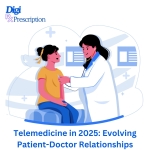Introduction
The rise of telemedicine has transformed healthcare accessibility, allowing patients to consult doctors remotely through telehealth apps, video calls, and AI-driven health platforms. In 2025, telemedicine is more advanced than ever, improving patient-doctor relationships, reducing healthcare costs, and making medical care accessible to millions worldwide.
This article explores how telemedicine is evolving, its benefits, challenges, and the future of virtual healthcare.
1. How Telemedicine is Changing Healthcare in 2025
The Rise of Telehealth Apps
Telemedicine is no longer just a convenience—it’s a core part of modern healthcare systems. Patients can now:
✅ Schedule virtual appointments with doctors anytime, anywhere.
✅ Get instant medical advice through AI-powered health chatbots.
✅ Receive remote monitoring for chronic conditions like diabetes and heart disease.
✅ Access electronic prescriptions (e-prescriptions) instantly.
Popular telemedicine apps like Teladoc, MDLIVE, Practo, and Doctor on Demand have made healthcare more accessible, efficient, and affordable.
Key Technologies Driving Telemedicine in 2025:
???? AI-Powered Virtual Assistants – AI chatbots handle basic health queries and triage patients before human doctors step in.
???? Wearable Health Tech Integration – Smartwatches and wearable ECG monitors send real-time patient data to doctors.
???? Remote Diagnostics & At-Home Testing – Patients use home test kits for conditions like COVID-19, cholesterol, and kidney function, with results analyzed remotely.
???? 5G & High-Speed Internet – Enables seamless video consultations, even in remote areas.
2. The Impact of Telemedicine on Patient-Doctor Relationships
More Accessibility & Convenience for Patients
???? Rural & Remote Areas: Telemedicine bridges the gap for patients in underserved regions who previously had to travel long distances for medical care.
???? 24/7 Consultations: Patients can consult a doctor anytime, avoiding long waiting times at hospitals.
???? Lower Costs: Virtual visits are often cheaper than in-person appointments, reducing out-of-pocket expenses.
Personalized & Continuous Care
???? AI-Driven Health Insights: Doctors can analyze patient history & wearable data to offer more personalized treatments.
???? Better Follow-Ups: Telemedicine ensures consistent monitoring for chronic disease patients, improving long-term health outcomes.
????⚕️ Stronger Doctor-Patient Relationships: Regular virtual check-ins increase engagement and help build trust.
3. Challenges & Limitations of Telemedicine
Despite its benefits, telemedicine still faces some challenges:
⚠ Digital Divide: Not everyone has access to smartphones, internet, or digital literacy to use telehealth services.
⚠ Regulatory & Privacy Issues: Storing and transmitting sensitive patient data securely is a growing concern.
⚠ Limited Physical Examinations: Some diagnoses still require in-person tests, scans, or procedures.
⚠ AI Accuracy & Liability Risks: Over-reliance on AI-driven diagnostics could lead to errors or misdiagnoses.
4. Future Trends in Telemedicine
???? AI-Driven Diagnoses: AI will detect diseases faster and provide early intervention suggestions.
???? VR-Based Telehealth Consultations: Virtual reality (VR) will create immersive doctor-patient interactions, enhancing remote care.
???? Blockchain in Telemedicine: Securing patient data with blockchain will enhance privacy and compliance.
???? More Insurance Coverage for Telehealth: Governments and private insurers will expand telehealth reimbursement policies.
Conclusion
In 2025, telemedicine has become a fundamental part of healthcare, improving accessibility, affordability, and the patient-doctor relationship. With advancements in AI, wearable health tech, and remote monitoring, telehealth will continue to evolve and shape the future of medical care.
However, challenges like privacy concerns, digital accessibility, and AI reliability must be addressed to ensure telemedicine remains safe and effective for all.
???? What’s your experience with telemedicine? Would you prefer virtual consultations over in-person visits? Let us know in the comments!
References:
- World Health Organization (WHO) – The Future of Telemedicine: www.who.int
- Harvard Medical School – AI in Healthcare: www.health.harvard.edu
- Telemedicine & Wearable Tech Research – NIH: www.nih.gov
- Global Telehealth Market Growth Report: www.telemedicinenews.com

